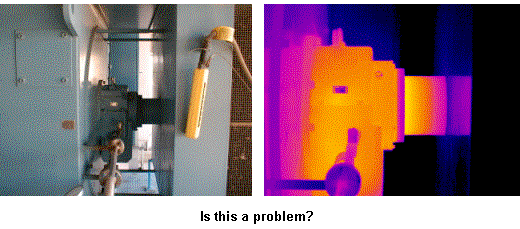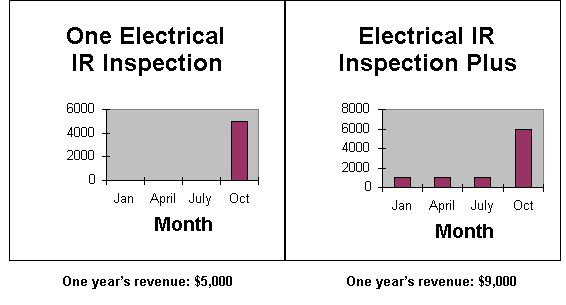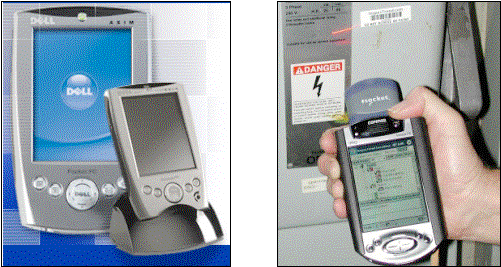Buried in Paperwork? Time, Tools, and Trends in the Infrared Industry
Scott Cawlfield
Logos Computer Solutions, Inc.
3801 14th Ave. West
Seattle, WA 98119
206-217-0577
Abstract
As more jobs are shipped overseas and companies continue to downsize, many people see infrared inspections as a great way to start a new career in the high tech field of Predictive Maintenance (PdM). The infrared industry is a growing market, as we can see in the increasing number of infrared cameras sold each year. Finding problems with infrared before they blow up or burn up equipment saves companies millions of dollars each year. Once you have an infrared camera and have attended a qualified infrared training course, the future of your business depends on how well you execute your infrared service.
This paper will discuss:
2. Tools used in the infrared industry and how to maximize their benefit
3. Finally, looking at the trends in the infrared industry, how they can affect you and how you can capitalize on them
Introduction
Often the best inspection tips and tools are in response to emerging trends within the infrared industry. One trend in the industry is the falling prices of infrared cameras. With the lower prices though, more cameras are being sold into the market every year. What this trend means is that there is a lower cost barrier to get into the infrared inspection business and more people are doing this and increasing the competition in the market. This ultimately puts a downward pressure on the daily rate of inspection services. Faced with stiff price competition, companies can take 2 different approaches to this downward pressure on prices. Some companies choose to bid or match the lowest price per day of their competitors. This can put a company in a downward spiral of doing more work for less money. Someone can always undercut your prices. Many companies doing this have struggled and some are no longer in business. Other companies have kept their price up and even grown in this same market by differentiating themselves from their competitors. Few successful infrared inspection companies live by IR alone.
It’s been shown that it costs 10 times more to sign up a new customer than to generate revenue from your existing customers. These successful companies were able to generate more revenue by selling additional services to their existing customers. These services included baseline trending of motors with IR, visual inspection for safety, ultrasound, motor circuit testing, power quality, IR training services and electrical repair services to create or maintain other revenue streams. For example, an industrial manufacturer might need an electrical infrared scan only once a year, but if you add mechanical infrared scanning by baseline trending his motors, you might need to do that on a monthly or quarterly basis.

When looking at motors, it is not easy to tell if a problem exists, such as overheated bearings, unless you baseline trend the motor over time. Infrared will not necessarily tell you what is wrong, but with experience, you can quickly scan with IR to identify a

potential problem on a motor. Then you can use other PdM technologies like motor circuit testing, oil analysis, or vibration to define what the problem is. By augmenting your infrared services with complimentary PdM technologies you can add value to what you’re delivering to your customers, increasing revenue and smoothing out some of the seasonal highs and lows of infrared.
By capitalizing on their existing customer base and selling them additional services, these companies were able to make their business survive and even grow while making it harder for low priced competitors to come in and steal their customers away. By adding complimentary PdM inspection technologies and setting the service bar higher, companies can capitalize on their existing customer base.
Another trend in the industry is the growing education, awareness and success of infrared as a PdM technology. Many companies are realizing huge Return on Investment (ROI) savings and improved production because of using infrared. This is especially true for insurance companies. Insurance companies pay out millions of dollars for claims each year and many of these claims are investigated. What they have found is that many of these claims are preventable by using infrared to identify problems and fixing the problems before they blow up or burn up. By comparing claims data of their insured that have an accountable infrared program against those that don’t, the insurance companies have realized a major difference. When infrared inspections were done properly and accountably AND the problems identified were fixed before they burned up or blew up, they found dramatic cost savings for their insureds and themselves from a reduced number of claims.
As this education trend grows and more and more insurance companies realize the cost savings of using infrared, they are requiring their insureds to have accountable infrared inspections done as a basis for underwriting the insurance policy. Generally, this is great news for the thermography business but it is a double-edged sword for the thermographer. Those who can capitalize on this trend by doing the inspection work required by an insurance company or by becoming a preferred infrared provider for an insurance company, can potentially increase their business without a lot of additional marketing.
On the other hand, the insurance companies will expect you to keep a comprehensive inventory list of what you have and have not tested. With this new knowledge in the insurance companies, you might also be held responsible if you don’t do a thorough and accountable job of documenting your work, especially in case there is a fire on the equipment you previously inspected.

One of the biggest improvements an inspection company can make – especially if it is successful and growing, is the automation of the inspection reports process. Besides infrared cameras, thermographers are one of the most important resources an IR inspection firm has and a large part of their expense, so utilizing their time wisely is very important. On average, for an 8-hour inspection day finding 20 problems, it will take the thermographer 2 to 4 hours to generate a report. So a thermographer who does 120 days of IR inspections per year can take up to 60 days doing reporting and paperwork. In this competitive environment, most inspection firms cannot charge for report generation. So if you charge $1,000 a day for IR inspections, that is $60,000 in unbillable time going to inspection reports. If you can reduce your report generation time from 4 hours down to 15 minutes, however, you can reduce that 60 days down to 4 days. Now what you do with those extra 56 days is up to you. You can do more inspections, take some time off, or spend more time with your family.
Another benefit of automating your inspection reports is that if you can do them in 15 minutes, you can leave the report with your customer at the completion of the job. The customer no longer has to wait 1 to 4 weeks to get the report back. This is a significant differentiator between companies that can do this and those that can’t. With current computer technology, the trend is to create the reports on a laptop in Adobe Acrobat format (.pdf) and burn the reports onto a CD at the customer’s site. Now the customer has the report as soon as the inspection is done and they can start the work order and repair process. The printed copy of the report can be sent later if the customer wants a printed copy. Some companies are not requiring a printed copy when they have the reports on a CD. This can save on printing costs and time. Also, with the automated report generation, you can speed up your cash flow by invoicing the customer when the inspection is done, instead of waiting 1 to 4 weeks later when your final product, the inspection report, is shipped.
Ways to Automate Your Reporting Process
Many camera manufacturers have upgraded their software to make it easier to automate the reporting process. If you don’t have the latest camera manufacturers software, see if this will benefit you. This is one way to speed up and automate your reporting process. Even if you don’t have an automated reporting system, you can still take a computer laptop out in the field with you and give a preliminary report to the customer with your report software or MS Word and/or burn the report on a CD burner. At least the customer will have a preliminary result from the IR inspection with the final report to follow later. With a preliminary report delivered, sometimes you can invoice the customer right away and speed up your cash flow even though they don’t have the final report delivered.
Beyond documenting the anomalies you find in the field and as was mentioned earlier regarding doing infrared scanning for insurance companies, you may be required to keep an equipment inventory list. The paper method is very simple but not very efficient and does not utilize some of the technology available today. Another approach is to record your data, track inventory inspection status and generate reports electronically – with a tablet computer or PDA in the field. The general trend for computers has continued to be smaller, lighter and cheaper. You are going to have to put all this inspection data into a computer to produce the reports eventually, so why not start entering it during the inspection? For inventory control, you can use Microsoft Excel for your inventory list on your computer and take it out in the field with you on an 8 oz. Personal Digital Assistant (PDA). The PDAs come standard with MS Excel built into them on the Microsoft Pocket PC platform.

By updating from a paper method to a PDA in the field, you can effectively cut out double entry and possible transcription errors when you translate your information from paper field notes back into the computer. This can save you time and money while increasing your accuracy. There are also commercial infrared inspection packages available that will run on tablet PC’s and PDA’s that will automate and improve your inspection efficiency while also reducing your paperwork and report generation time. Some commercial programs cover the complete workflow process from inspection scheduling, inspection inventory, problem documentation and reconciliation, baseline trending, bar coding and report generation. Also, some programs even have integration with CMMS systems like Maximo and web managers to access the reports over your LAN or internet.
Infrared Standards
Insurance companies also like industry standards and would like you to adhere to them. Right now there are many professional associations like ASNT, NETA, NEMA, ASTM, IEEE, NFPA, ISPoT, etc. but are you aware of what is in these written standards? If you do know, do you follow them? For example, is there one standard for defining a person as a “Thermographer”? Does a camera and passing a qualified training course make you a Thermographer? Does a camera, a qualified training course, and field experience make you a “Thermographer”? If field experience is required, how much? What about specialty fields such as roof inspections, building envelopes, heater tubes, or medical infrared scanning. All of these take special knowledge in these fields. Anyone can go up on a roof with an infrared camera. And they can just as easily fall off the roof without the proper training. By looking up these standards and possibly joining these organizations, you can further your infrared education and your customers also might like to know that you belong to a professional group. This is another way to differentiate you from others.
Computers and the Internet
How do trends and advancements in computers and the Internet affect a thermographer? Well, to start, access to information and knowledge transfer. This is the information age and there are web sites with all kinds of educational information accessible from a computer connected to the Internet. Information on infrared standards, news groups with current information on new camera technology, chat rooms where you can ask a question and another thermographer across the country may have the answer for you are fairly easily accessible to us all. You can now even take IR certification courses online.
Another area of growth in the Internet is the connectivity of people and information at your fingertips. These web tools are changing things dramatically. Infrared reports are viewed and analyzed over the Internet and intranet (local area network of a company). Managers want to go to one place to see their data and utilize a web enabled solution allowing them to tap into the network that connects most companies together internally and externally, locally, regionally and even internationally. Can you, other engineers or managers access your IR data and reports from anywhere in a plant; from any plant within the enterprise; from anywhere in the world? Being able to create a library of thermal results and reports, to trend items over time for engineers to monitor, to produce cost justifications that accountants can see on their web browsers immediately will set you or your company apart from the pack. This is where trends and advancements in computers and the Internet will play a big part of the growing future of the infrared industry.
Conclusion
Questions to consider as changes and trends are happening in this industry.
2. Are you buried in paperwork? Can you automate your reporting process?
3. Do I have any contacts in the industrial insurance business?
4. Are you keeping an accountable inspection inventory of what was tested and what was not tested?
5. Infrared standards: are you aware of them and do you follow them?
6. Will a membership in a standards group enhance my professional education and credibility?
7. How do I differentiate my IR business from all the other IR companies?
8. Will adding other PdM technologies enhance and grow my IR business?
As the infrared industry continues to mature, changes are happening. Are you going to capitalize on them?
Advertisement


